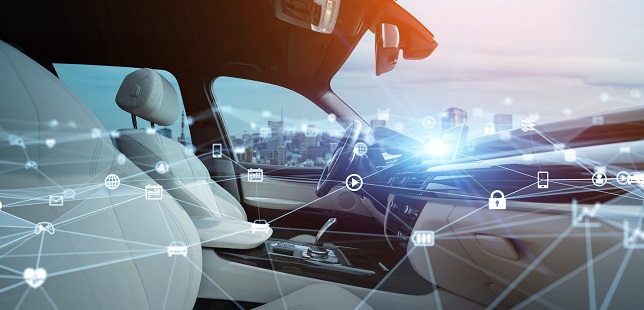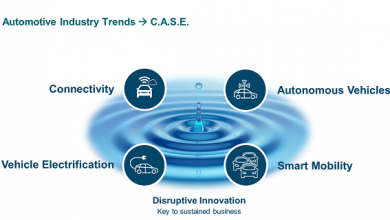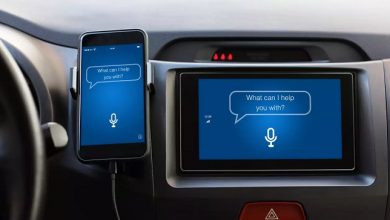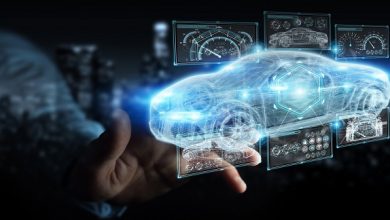Software, not horsepower, will differentiate cars of the future

The way in which vehicles interact with drivers’ daily lives is changing. The rapid growth of connected vehicle technology has dramatically changed the way in which vehicles are designed, developed and manufactured, with code and computing power now becoming the fundamental focus of next-generation vehicles.
The global connected vehicle market is expected to treble in size by 2027 to $49bn. Leading automotive manufacturers are already exploring how to capitalise on both the technology and growing demand, with 100% of new vehicles currently being built in Europe and North America being ‘connected’.
In fact, every second vehicle on US and European roads in total will be connected by 2025, with China and Japan to follow shortly after, according to PWC’s 2021 Digital Auto Report. Automakers, who have previously differentiated themselves from each other by their mechanical features, such as horsepower and torque, now have an opportunity to look to integrated software solutions to appeal to consumers who are increasingly looking for their vehicles to provide valuable features, that not only complement their daily lives with driver-assistance features, but also tailor these services to their individual needs.
VW Group CEO, Herbert Diess, recently commented that the German marque will have to “completely change to a digital company”, if it’s to remain competitive in a fast-changing market, and that the VW of the future won’t simply just make cars, it will have to continually develop software to run them as devices.
Drivers are looking for automakers to provide the technology necessary to ensure positive future user experiences, such as finding real-time available parking and EV charging, frictionless in-car commerce through enhanced functionality, and the introduction of autonomous systems – all integrated via their vehicle’s infotainment systems.
Automakers are facing an industrial shift in vehicle development, with the focus now firmly on their integrated software. The transition to electric powertrains and autonomous systems is pushing automakers to rethink not only their model line up, but also their roles as manufacturers, and how they will differentiate their vehicles from their competitors’ offerings in the future.
Retaining driver loyalty
McKinsey’s study on trendsetting car buyers shows that 40% of respondents are willing to change car brands simply for better connectivity features. It is becoming evident that the ability to remain connected is no longer a luxury for most consumers – it is an expectation, and one that now also applies when travelling by car. Consistently strong consumer demand continues to make connectivity features a priority for buyers, with automakers striving to offer the latest innovations in this area.
McKinsey’s research also suggests that autonomous driving will open even greater new opportunities for connectivity features, with respondents stating that they expect that with autonomous driving, they would use the infotainment system (including for movies and music) for roughly 20% of their travel time, an additional 8% for online shopping, and the rest talking to other people in the car, sleeping, or simply looking out of the window.
In a future where professional drivers and chauffeurs have the potential to be replaced by autonomous self-driving systems, car owners will have much higher expectations of in-car entertainment – greatly in excess of smartphone levels of functionality through their infotainment screens, with the added benefits of deep vehicle systems integration for heightened convenience, comfort and safety requirements. Automakers who can successfully incorporate future mobility and convenience features together into their vehicles today, will undoubtedly appeal to tomorrow’s customers. The challenge now for the automakers is to recognise which features drivers really want and how to ensure that the data these features are built on is reliable enough to deliver repeatable positive user experiences.
Biometrics
The introduction of vehicles with keyless ignition has caused an increase in thefts, which has become a major issue for automakers. Biometric-based authentication, which involves the use of biological markers, such as fingerprints or facial recognition, can provide a more secure and potentially lifesaving alternative.
Wellness tracking, where sensors in the steering wheel can detect changes in heart rate, stress levels, and even fatigue, is actively being pursued by automakers. Wellness tracking could ensure greater safety, as the car would be able to forewarn the driver of any cognitive impairment that could greatly affect safe driving – combined with active ADAS systems, this would provide a key safety feature for autonomous driving systems, and potentially prevent the many accidents every year caused by medical emergencies at the wheel.
The use cases for biometrics can also be extended to ride-hailing firms, as these can be used to identify both drivers and passengers, as well as a method of prevention for ‘friendly fraud’. Now vehicles have the ability to store payment information, car sharing can lead to using a family member’s information to make payments for vehicle-centric services or e-commerce products from behind the wheel. Biometrics in this instance would be a definitive way in which automakers can complete secure purchases within in-car commerce.
In-car commerce
Entirely centred around driver’s needs while behind the wheel, in-car commerce is currently one of the leading in-car focuses for automakers who are looking to optimise their driver’s user experience. However, OEMs need solutions that can work almost anywhere, ideally globally, and for vehicle-centric services such as parking, EV charging, fuelling and tolling, a North American or a European wide solution can easily mean having to deal with hundreds of merchants in dynamic markets. Today, automotive OEMs are not equipped to manage this scale of fragmentation and complexity in markets outside their core business.
A number of in-car marketplaces have been launched – in particular in North America. However, many of these have garnered very little driver engagement, and transaction volumes remain limited. The industry is going through a learning curve when it comes to in-car commerce, however, one initial observation is obvious – user experience is key.
To create true value for their users with in-car payments, carmakers have to deliver against the specifics of the driver experience. The in-car payment experience also needs to be comprehensive, efficient and integrated, and any viable in-car payment solution must aggregate multiple merchants and provide sufficient coverage of transactable locations to make it worthwhile for drivers.
To make in-car payments successful, the entire user experience needs to be complete and deeply integrated with the navigation, including locations without transaction capabilities. A frictionless solution requires centralized user management, with Single Sign-On (SSO) capabilities across all merchants, covering all connected car services and the associated payments. This SSO setup needs to be frictionless and consistent for the driver across all commerce domains. The payments need to be seamless too – orchestrated across the plethora of payment service providers and without additional enforced customer authentication at the point of sale. The driver should not have to pull out a smartphone to approve a payment, the in-car solution should take care of that.
Telematics
Telematics can be invaluable for both safety and driver convenience. By monitoring vehicle location, routes and driving style, automakers can provide personalised services, as well as predictive maintenance. Vehicle-to-everything (V2X) will be hugely beneficial for navigation-routing and vehicle-to-vehicle communication by allowing a car’s centralised back-end servers to calculate the best routes using the most recent road and traffic conditions. The information used to calculate instant re-routing can also be shared back to servers and between other drivers, as can information such as poor road conditions, road closures and parking space availability.
Alongside traffic and weather, parking is the most requested driver information service. Every driver’s journey begins and ends with parking, however, automakers who don’t already prioritise parking, or are content with poor quality data, are creating negative user experiences for their drivers. Research found that motorists can spend up to 90 hours every year looking for parking in major cities. Smart parking solutions are necessary to reduce the time spent looking for parking, unwarranted consumption of fuel, and to reduce greenhouse gas emissions.
Parking data will also form the basis of many next-generation connected vehicle payment and mobility services – from the adoption of electric vehicles to automatic parking payments and autonomous driving. Ensuring this data meets auto-grade standards will be paramount to future driver user experiences.
Ensuring data accuracy
In-car systems of the future need accurate, granular and comprehensive data to support highly automated vehicle-centric transactions – parking, fuelling, tolling and EV charging currently hold the biggest opportunity for car manufacturers. The more seamless and automated in-car transactions are, the higher the benefits for the user and also the car manufacturers and merchants in delivering more convenient experiences that give drivers the option to easily order, reserve and make payments safely and efficiently from their vehicles.
The success of future technology will depend on the quality of the data it is built on. When collecting large amounts of data, accuracy can sometimes be lost. As the global leader in digital parking services, Parkopedia’s database of parking spaces around the world now exceeds 70 million, in 15,000 cities across 89 countries. As well as frequent testing to maintain the accuracy and completeness of the data, Parkopedia is continually working to close any gaps in coverage, such as within indoor and underground facilities, and in less populated areas.
Parkopedia’s data collection includes gathering dozens of static parking data attributes for every location including the precise location, as well as details on the number of spaces, prices, hours of operation, electric vehicle charge points, height restrictions and more. By leveraging parking payment transaction data, digital imagery and vehicle sensor data to provide highest quality predictions, Parkopedia’s dynamic data provides space occupancy information, as well as “probability to find parking” by individual street segments and for off-street parking facilities.
To ensure the quality of data when it comes to coverage, completeness, and accuracy, Ground Truth Testing (GTT) is an important tool for the automotive industry and mapping providers by helping them evaluate quality amongst data providers by exposing the level of correctness and accuracy across both static and dynamic attributes by visiting multiple locations and comparing the information available from the data provider with the information available at the locations. While this process may seem simplistic, evaluating Point of Interest (POI) data is a complex and crucial process that requires planning to give a consistent and fair evaluation between competing suppliers.
Leveraging data to delight drivers
Connected vehicles in the future will be defined by data. Either the data that its services are built on, or the data collected from the driver’s engagement with the vehicle or provided services. By leveraging the data collected from the vehicles themselves, automakers are able to produce a customised and engaging interface for drivers which will encourage positive in-vehicle user experiences. In the competitive world of connected vehicles, automakers need to continually improve their driver touchpoints to maximize their user experiences. By doing so, they will retain existing owners, appeal to new customers, and continue to capitalise on demands for the latest services and technology.
Automakers leveraging vehicle sensor data will be critical to future success, not only in terms of prompting drivers in real-time to generate engagement and interaction, but also to provide hugely valuable insights into in-car user behavior which will help optimize the in-car commerce propositions and overall experience. The ability to harvest real-time usage scenarios offers potentially huge savings in R&D budgets, while user data can expedite hundreds of hours of in-car software testing, and monitor acceptance of additional systems, such as voice assistants, automated personal preferences with AI technology, context-aware vehicle services and ‘useful’ driver prompts enabled by deeply integrated systems. Making sense of vehicle data to create great user experiences and unique experiences will be the key differential in terms of future customer loyalty and potential monetization.
Author:

Dr. Hans Puvogel
COO
Parkopedia
Hans has 25-years’ experience in software and data services for the automotive and telecommunications industry. As COO at Parkopedia, his main responsibilities include driving sales and marketing, as well as managing operations across our markets in Europe, North America, Latin America, and Asia.
Published in Telematics Wire





